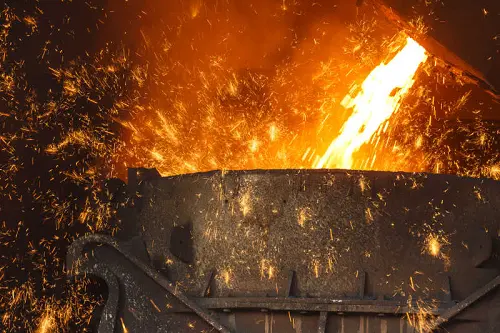
Knowledge
Improving the Metallurgical Quality of Cast Steel (Part Three)

Key Points of Aluminum and Calcium Deoxidation
1. Aluminium Deoxidation
The amount of aluminum used for final deoxidation of molten steel should be appropriate. Insufficient aluminum will result in a residual aluminum content exceeding 0.04%, which can lead to type II inclusions and affect the steel's properties. Excessive aluminum may cause harmful type II inclusions and may also result in "stone-like fracture" defects. Special fractures that occurred in cast steel parts were later confirmed to be mainly caused by aluminum nitride (AlN). To avoid "stone-like fracture", the aluminum content must be strictly controlled, with the upper limit generally below 0.12% and not exceeding 0.14% at most. At the same time, the aluminum recovery rate should be stable. Methods of adding aluminum for deoxidation include gradually adding small pieces of aluminum into the molten stream or fixing them on a steel rod and inserting it into the molten steel. Some foreign factories use aluminum alloys containing 35% aluminum for indirect aluminum addition, which has a good effect.
With the increasing quality requirements for cast steel parts, the combined use of aluminum and other deoxidizers can further reduce the oxygen content in steel and improve the morphology and distribution of inclusions.
2. Calcium deoxidation
Calcium has a low density, a low boiling point, and strong reactivity, making it difficult to control and limiting its application. Calcium has a stronger deoxidation ability than aluminum and magnesium, but it has a low solubility and a lower melting point than molten steel. Using calcium alone for deoxidation is not very effective. However, when combined with aluminum and magnesium, it can reduce the oxygen content in steel to below 0.002%, prevent porosity in castings, and improve the fluidity of molten steel and the surface quality of castings.
Effect on non-metallic inclusions: The Al₂O₃ inclusions formed by aluminum deoxidation are fine and difficult to float. After adding calcium, the formed calcium aluminate particles are larger and easier to float. Some calcium aluminate is liquid at steelmaking temperatures, making it easier to carry other inclusions to the surface. For high-quality castings, calcium treatment is necessary. For cast steel, deoxidation with aluminum followed by calcium treatment, with a 2-minute rest, can reduce the total amount of oxide inclusions in the steel by 60 - 70%, and increase the impact toughness at -18°C by an average of 70%.
3. Calcium addition methods
① Spray refining: This includes powder injection, wire feeding, and aluminum projectile injection. Powder injection involves spraying calcium alloy through a lance, which reduces calcium reactivity and increases recovery. Silicon-calcium alloy is commonly used in practice. Wire feeding is suitable for large, medium, and small enterprises, stabilizing aluminum recovery and improving steel quality. Aluminum projectile injection involves injecting steel with calcium alloy wrapped in aluminum sheets.
② Direct addition of alloys: Calcium is combined with other elements to form alloys, which are then added directly to the molten steel after reducing reactivity. For example, replacing calcium in silicon-calcium alloy with barium can reduce reactivity, with barium acting as a buffer. Using silicon-calcium-barium alloy in combination with aluminum has complementary benefits. The alloy is best added after or simultaneously with aluminum. The dosage varies by steel type. For example, for carbon steel and low-alloy steel, add 0.5 kg of aluminum and 2 - 2.5 kg of silicon-calcium-barium alloy per ton of molten steel; for austenitic stainless steel, only the alloy is added; for ferritic stainless steel, a small amount of aluminum may be added additionally.
Vigor has more than 18 years experience on castings. If you have any question and demand of products development or improve your supply chain, please feel free to contact us at info@castings-forging.com



